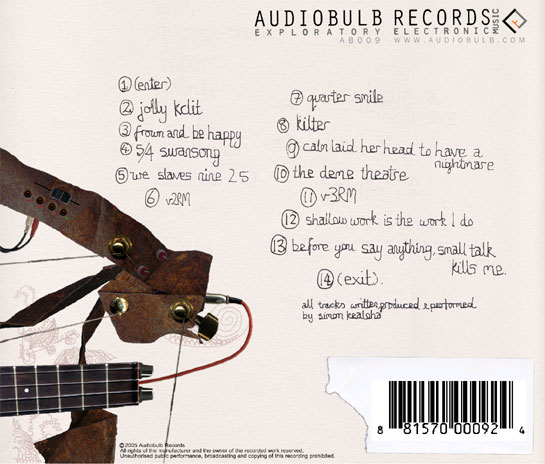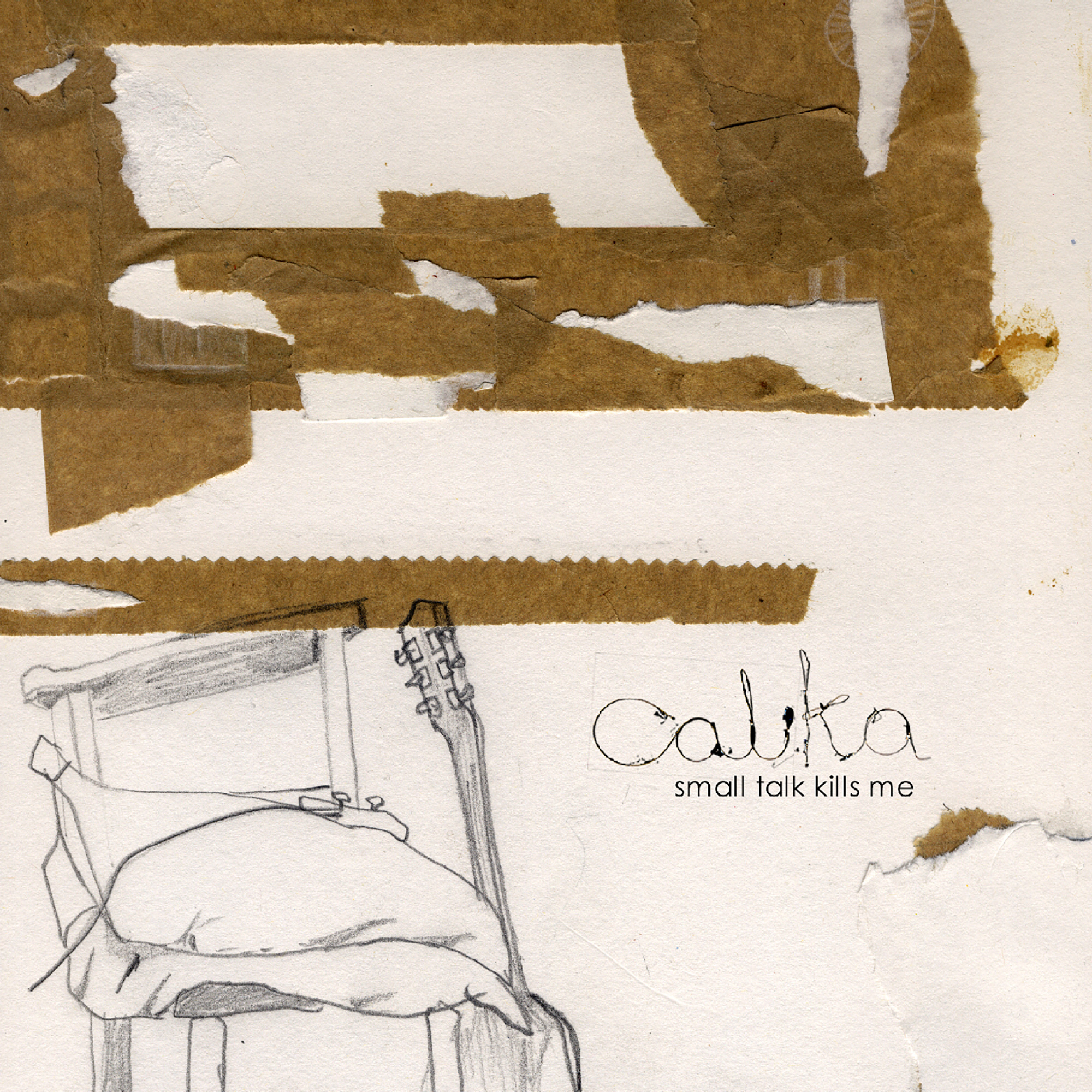Tracklisting:
- (Enter)
- Jolly Klit
- Frown And Be Happy
- 5/4 Swansong
- We Slaves 2 5
- v2RM
- Quarter Smile
- Kilter
- Calm Laid Her Head To Have A Nightmare
- The Deme Theatre
- v3RM
- Shallow Work Is The Work I Do
- Before You Say Anything, Small Talk Kills Me
- (Exit)
Interview with Vito Camarretta
Hi Simon. How are you?
Very well thank you.
Why did you choose the moniker Calika?
Well i had wanted to use my middle name 'alika' (which is Hawaiian, I'm half Hawaiian), but that was already being used by a Thai pop star. At the same time as choosing the name i had been reading allot of Albert Camus (after many failed attempts at understanding Satre) and grabbed the C from Camus and hey presto. It wasn't till started receiving lots of emails from buddhist forums that i realized that it had buddhist connections but by then it was set in stone.
Small Talk Kills Me is your debut. What a stunning title!
Truly ironic! Any yawn for society rules (and society’s musical tastes and/or marketing rulers’ imposition)? A few people have taken exception to the title and it's 'minor profundity' but it wasn't intended to be a big statement on the position of small talk within society, just a statement on my experience of the society which surrounds me. Yeah, I hate the culture of 'small talk', in the sense that everything seems very throw away i.e. conversations I have with some people, marketing and advertising, quick fix politics, manufactured music and a million other things, but that form of small talk is as much a fault of mine as anyone else's. I suppose I'm just trying to say that in my own little way I'm trying not to nurture that type of culture, because there's so much more i could do with that time. Plus, all that aside, i just like the sound of it.
I’ve re-listened your music. Common listener will notice the total absence of loops as well as that you don’t betoken any corruption from “traditional” way of composing. But we notice your “snaky” way of treating sounds which is even more uncommon... And that sketchy guitar and those pillows in the cover-art... Could you talk about the way you treat them?
I've consciously tried to stay away from the traditional approach of music composition because find it limiting, and i think limits in creative areas are detrimental to development, although, it's still evident in my work.
As far as treating sounds, i think the best way to go is anything goes. A few years ago i met Mark Clifford and he helped me to understand music as sound rather than simply as melody etc. the development of technology in music over the last ten years has been staggering, especially with programs like MSP/Max and reaktor (which i use). they've allowed me to take the acoustic sources and treat them in ways i could never have imagined, which is so exciting for any artist who is interested in sound as well as composition.
The guitar etc in the cover art was just an attempt to humanise the album, as although it is filled with live instrumentation i think of it as a very electronic album, plus no one seems to have noticed yet that i forgot to draw on the fourth leg of the chair. really it should have fallen over by now.
A lot of people involved in experimental music says that they refuse spotlight, but if BBC should broadcast your music...???
I'd be quite happy to have the BBC broadcast my music as it wouldn't be a compromise of the music. The music would still be the focus. the only problem i would have it with advertising. i don't like the idea of that, with the music being used to push a product, then the focus is not on creative expression but on profit maximization. i have heard there is a debate about Brian Eno allowing his music to be used on an Orange mobile ad and how many fans can't listen to the album anymore. i think it's from music for airports. i have seen the advert and i have to admit that as a purely visual/audible work i really like it and probably would still enjoy the album.
Some tracks looks like a spongy spluttering, more or less like David Toop experimentations, even if less “realistic” than field recordings. What do you think about field recording?
Pure field recording is an art and something that i would love to learn more about. OTI on audiobulb has done a wonderful album called recollections which is a study of field recordings with melodic backdrops and for me is the perfect balance. I've tried to listen to various recordings on Folkways etc but my ear just aren't tuned to it yet and it is something that i have to learn to listen to. i have to admit to not having heard much of David Toops music so I'm not to sure about his experimentations. I've read Oceans of Sound which a great book for anyone to read to get a background on the development of music, and while i was living in London i went to see a sound art exhibition he put on at the Hayward. I'll go and search out some music.
Swans are very famous in electronic music nowadays. I listened to another noisy track (very good) by Xopher Davidson (Swan Lake taken from its recent issue).. Swans are maybe the strangest bird of this world as they are generally associated to the idea of “beauty” but their sound is not like the merry note of the skylark...
I assume you're referring to the track '5/4 Swansong' from the album, which i guess could be described as pretty noisy track. For me it is the best marriage of acoustic and electronic sources which i have managed to achieve so far. each element very distinguishable in it's own right, but also working very well together as a whole. The title for the track is purely about the structure and sound of the piece. '5/4' for the time signature and 'swan song' because apparently swans are supposed to sing a very melodious song when they die, and the track as it comes to it's conclusion for my ears becomes allot more beautiful and melodious towards the end until it finally dies.
I am very curious in knowing the way you assembled Kilter...
Kilter was simply the result of wondering around the flat with the guitar plucking on strings until something worked for me. i kept those note pretty much intact and clean, and then put the rest through the ringer. i tried to keep as much space and air in the track as possible so it feels more simple and uncluttered, hence the very dry drums etc, hopefully adding a little dynamic to the structure of the album.
Any work in progress?
Well i have also just released a collaborative album with Mark Clifford of Seefeel as Clifford/Kealoha called 'running taper' on Polyfusia Records. Also early next year I'll be releasing some material as 'CEK' which is a band I'm involved with featuring Mark again and Eda, formally of the Boredoms. i play bass and the overall sound is very hard to describe. the best i can say is that it is very free and open. I've been planning a project with Erik Schoster (He Can Jog) for a while so hopefully that will see fruition at some point and other than that I'm always working on more Calika material for the next album.
Calika
Calika is Simon Kealoha an artist focused on exploring the uneasy interface between electronic and acoustic music. Simon has already released music on the UK Polyfusia label as one part of Clifford/Kealoha (a collaboration with Mark Clifford from Seefeel). Simon’s solo work brings forth a distinct aesthetic. His work combines timbres born from the strings of dismantled piano’s, harps, mouth organs and seemingly dismembered voices. The nuances of these sources are combined with Simon’s guitar and synthesiser playing and set against an off-kilter backbeat of percussion made from found-sounds and distorted drum kits. The detail contained within the work is what immediately strikes you. This combined with Simon’s talent in selecting unusual but complimentary sounds to produce a coherent final picture. Simon works on his music day and night. His work is time consuming, obsessive, and compelling to listen to.





Reviews
The Milk Factory
Using anything from strings of dismantled pianos, a harp or a mouth organ to an acoustic guitar and found sounds, Kealoha arranges his compositions with great care, building on the delicate aspect of his sound sources to alter the mood of each track. All the way through, Kealoha applies gentle touches and delicate tones, creating intricate sonic vignettes, all working independently from one another. The scope explored with this album and the maturity with which Kealoha processes his compositions are rather impressive. Despite its great diversity, a consistent theme emerges as the album progresses, and with it overall coherence. Small Talk Kills Me goes well beyond most contemporary electronica to reach warm and welcoming sonic grounds while remaining entirely experimental. With an undeniable taste for wonderfully stimulating sound assemblages, Kealoha ensures this album remains consistent and stimulating all the way through. This is the very promising debut album from a man with an extremely pertinent understanding of musical structures and a visionary approach.
Boomkat
What with Big Brother replacing the weather as Britain's stock subject for small-talk scenarios, it seems Calika has decided enough is enough; declaring any more chat about Galloway dancing to Kraftwerk whilst wearing a pink leotard will kill him. So there. Harking from Brighton and sounding nothing like The Go! Team Wrong Music axis which seems to dominate his piers (get it?!), Calika (aka Simon Kealoha) has produced an album of crisp'n'dry electronica that eschews loops in favour of electronically disrupting acoustic compositions with all manner of fizzes, creases and filtered inputs. Tracks like 'Jolly Klit' and 'Kilter' allow waves of fuzz to drift in and out on a tide of finely wrought beats and kinetic bass, whilst elsewhere 'Frown And Be Happy' hiccups along with a structure that only makes sense from above and '(Exit)' indulges in some Prefuse beats to charming effect. Incorporating field recordings and electronically soused vocals throughout adds another layer to 'Small Talk Kills Me' that neatly reconciles the homespun image Calika projects with the laptop sphere in which he inhabits. How's the weather?
Igloo Magazine
Calika's debut release, Small Talk Kills Me, isn't what I'd call background music. It's not music you can put on and let become ambient, lulling sound. Small Talk... is an unexpected blend of sounds created by solo artist Simon Kealoha. He explores territory that most electronic artists seem to shy away from; a marriage of acoustic and electronic. And as I was listening to it again while driving home one night, I realized that it could very well also be described as a missing soundtrack to Darren Aronofsky's film Pi.
Like the multifaceted images that Pi presented, Small Talk... gives us layers of sound to sift through. A contradiction of textures, from organic to sensual to almost sterile in precision; a contradiction that couldn't be more agreeable. Each track blends individual pieces of noise, deliberately and carefully layered into sound with purpose. This isn't a random mishmash; rather, it leaves you wondering where the next sound will come from.
When listened to with headphones, this release becomes an audio dose of Alka Seltzer, with its jerks and quirks and ping-ponging. Surprising backgrounds of abstract vocals and acoustic guitar give some tracks a fluid, lilting momentum. Other tracks feature industrial, almost robotic chirping, or noise like disembodied keyboards that can be jarring, but that also create a curiosity for the ears.
It took a few listens for me to settle in and appreciate the intelligence behind Calika's first release. Through the business of the sounds and the unpredictability of each track's progression, I found that this is indeed not a CD to put in the background. Rather, it is one to listen to intently, to discover each layer, to appreciate the textures and to pay close attention to. Let's hope Calika continues to make music that follows its own rules.
Smallfish
Calika is Simon Kealoha who recently collaborated with Seefeel's Mark Clifford on the wonderful 'Running Taper' CD on Clifford's Polyfusia label. Having loved that piece of work it's really interesting listening to this as it puts into perspective Kealoha's input into the collaborative effort. This is just absolutely chock full of superb electronic music that clearly doesn't feel restricted in any way. He moves between classically melodic tracks and considerably more out there pieces that use organic instrumentation as a starting point and turn into engagingly oddball arrangements. When it gets beaty it really does have a lovely amount of oomph and there's obviously been a great deal of time spent composing the album as a whole. If you enjoyed 'Running Taper' you must count this as a 'must-check' and even if you didn't this easily stands as one of the best releases this year. Superb and highly recommended.
Textura
Given Simon Kealoha's aversion to small talk, we'll in the same spirit proceed directly to the matter at hand: assessing his Calika debut. While it flirts on occasion with conventional compositional structures, Small Talk Kills Me more often than not eschews familiar formulas for unusual comminglings of electronic and acoustic elements. Pianos, harps, and harmonicas bubble to the surface throughout, but Kealoha more typically constrains dispersive fields of electronic noises with the familiar pluck of acoustic guitars. In the first part of “Jolly Kclitt,” for example, whirrs and clicks morph into a loping pulse of throbs and clatter, until a simple acoustic guitar melody imposes a greater semblance of order in the second. There's a loose and explorative feel to the material that suggests a less rambunctious Oval (meanderings of flute and soft voice fragments in “Frown and Be Happy” recall So , Markus Popp's collab with singer Eriko Toyoda); the jittery, writhing pulses of “5/4 Swansong,” on the other hand, recall Autechre.
One of the more interesting things about Small Talk Kills Me is its trajectory. We move from “Quarter Smile,” a lulling setting of loping melancholia, to the restrained soul-jazz tropes of “Kilter,” then on to “Calm Laid Her Head to Have a Nightmare” which lightly floats gentle harp patterns over subtle traces of electronic flutter (though, as the title suggests, its peaceful sleep is eventually disturbed, specifically by churning industrial noise). As it approaches its middle, the album subtly gravitates towards more accessible territory until it pulls back again with “The Deme Theatre,” all woozy swirls of off-key vocalizing and warped squelches. Interestingly too, the title track (“Before You Say Anything, Small Talk Kills Me”) isn't aggressive at all but a placid meditation of gently lapping guitars and voice murmurs. If Small Talk Kills Me occasionally calls to mind other artists' styles, it more often than not surprises by pursuing not one but a large number of off-kilter directions.
Angry Ape
Small Talk Kills Me is the debut album from Calika, released on Audiobulb. Calika is Simon Kealoha, who has previously worked with SeeFeels's Mark Clifford, and released material on Polyfusia. Small Talk Kills Me is a well-accomplished album, calling to minds such established artists as B. Fleischmann, Boards of Canada and the more electronic side of Mum. Subtle and unassuming cut and paste electronica is used to its maximum effect, containing heaped beats and samples to create a wonderfully mature sound. Jolly Kclit uses ethereal vocals, underneath the many layers of soft electronic clinks and muted deep beats. The album becomes familiar very quickly, only adding to its charm and although complex in it's mixed up layers, is remarkably accessible. There are no "stand out tracks" as such; Small Talk Kills Me is consistent without exception. 5/4 Swansong mesmerises with hypnotising beats and miscellaneous found sounds, switching from organic to electronic, whilst Calm Laid Down Her Head to Have a Nightmare deconstructs into a gigantic buzz of sonic waves. Calika is simply sublime, and has barely left my cd player since I received it, shame on you who leave it undiscovered. 10/10.
Chain D.L.K.
It took most unusual CD to prompt me into writing reviews again. It’s not that I haven’t heard a lot of good music lately, just he opposite. I’ve been a bit overwhelmed in the past few months and my focus has become somewhat skewed. Be that as it may, leave itto Audiobulb Records to release a CD so different and intriguing that I can’t help but be impressed.Calika’s ‘small talk kills me’ is one of those rare recordings that stimulates right- brain activity in such a subtle way that you may hardly be aware of it ntil you’ve experienced repeated listenings.
On first impression, Calika’s music falls into the electronic glitch-n-paste category with a smattering of acoustic guitar and sing-songy wordless vocal samples scattered here and there. As a background ound palette, there is a feel of random activity over repeated patterns of disjunct melody. What’s really happening though, is that you’re entering into a completely different audial world, where conventional structure is abandoned, giving way to a new mode of xpression where an ever-changing, evolving tonal mood within the deepest realms of imagination.
At times the music crosses into the realm of the psychedelic, and we get the first hint of what could almost be considered a ‘jam’on track # 5, “We Slaves Nine 25”. Beyond that, abstract hallucinatory terrain is traversed and you get the feeling that ou’re no longer in the concrete world as you know it. There are sonic elements that may cause windows of memory to open and revealthings long forgotten. Perhaps one of the most dramatic shifts occurs in track #9, “Calm Laid Her Head To Have A Nightmare” and the track title is most apropos. A placid melodic repetition gradually gives way to a grumbling chordal drone that seems to go on for an uncomfortable period of time, then suddenly stops- as if the listener has suddenly awoken from a bad dream. More abstract hallucinatory terrain follows, and by this time, consciousness is stretched and bent in so many directions you’ll be hard-pressed to get your bearings. It is almost like stepping into a funhouse of the mind, and after this carnival of acousma is over, you’ll come out with an altogether new perspective, although you won’t be able be able to put your finger on why. And even when it seems to be over, it’s still not over. A hidden (untitled) 15th track reels you back in lest you forget the last 80 minutes you spent in wonderland.
Where most glitch-n-paste experimental music fails for me is in the lack of conceptual cohesion and too much percussive bombardment with too little payoff. Definitely not the case here. Calika has assembled something marvelous and special. If you’re a fan of Autechre, Boards Of Canada, Oval or Plaid you’ve just GOT to pick up this CD. Available directly from Audiobulb in the UK, and probably at your electronic music specialty shop, wherever you buy all the good stuff.
Gaz-Eta
Soulful electronica or folk meets electronica? Is this the future of this genre? Is electronic music getting a heart? Simon Kealoha's debut "Small Talk Kills Me" is a perfect instance of a meeting point of electronica, lounge and folk elements. An hour worth of what, you ask? Well, there are gentle hisses, lots of twangy guitars, soothing synths and soft beats and loopy samples. What Simon is going for is the feel and the textured sound. Scratched -up records, elusive toned-down keyboards and machines that feel warm to the touch; Simon is definitely exploring the tender side of the groove. This tender side is not to be confused with ambient music. Though it's lounge and even lazy, it's definitely not background music. An abrasive hissing hidden track even makes its way onto the record. What is truly amazing is the organic feel of every single track included. I'm talking about warmth and a comfort level that can't really be put into words. Let's put it this way, the sounds are not simple manipulations and experimental bits simply for experiment's sake. These are wordless pop songs from a land inhabited by soft electronica, folk music and lounge. It's great to see how the siblings get along so well.
Brainwashed
Simon Kealoha's Calika project brings a fresh perspective to bedroom vibe electronica. Fractured and reconstructed though it may be, Small Talk Kills Me is a record composed of songs more than experiments and that's a welcome change of pace.
While I enjoy some deconstructed instrumentalism on occasion, Calika drives home how the approach of beating up and making up sounds can work in an emotionally relevant way when everything is put together with care. Small Talk Kills Me is full of the kind of sonic detours and lapses into exploration that many artists make entire records out of, but those excursions are always roped in by structures and melodies. Knowing the difference between following a divergent path through a composition with a purpose and simply noodling is something that a lot of artists working with this sort of sound set never manage. Luckily, Kealoha is able to balance his need to experiment with his impulse to communicate here, and it pays off well.
"Jolly Kclit" starts off with some glitchy rambling that made me wonder if this album was going to chase its tail for an hour, but by the 35 second mark there's a stuttering beat, bass melody, and fragments of looped sound that build nicely into an emotional chorus. Guitar punctuates the mix, but this hardly sounds like the live-recorded sort of "folk music with a laptop" approach. I imagine that every sound that's been recorded here has been run through the digital ringer to make it sit in Calika's kaleidoscopic mix of song and noise.
The album's quieter moments recall experiments in field recording, but they too maintain a melody that drives them forward, keeping them from hanging around like so much wallpaper. "Quarter Smile" builds on some looped guitar and backwards melodies and a simple electronic beat that creates a perfect mood. There's even a Joanna Newsom reference in one of the song titles, which doesn't seem totally out of place even in a landscape of click- pop beats.
All of this reminds me of the album's title, Small Talk Kills Me, and as someone who resembles that title in every way, I find in this record the kind of thing I'll put on when I'm at home alone, not really seeking out any company other than a collection of comfortable songs. Small talk, like so many conventions of social interaction can deaden the spirit, and Kealoha realizes that being alone with your thoughts or a good record isn't necessarily isolationist posturing. This record plays like a knowing tip of the cap to all of the other bedroom knob twiddlers and 6-string strummers and bookish quiet types who'd just as soon interact via proxy than get together for drinks. We're all out here, Calika, and we hear you just fine, we just may not be seeing you out at the pub any time soon.
Sonic Curiosity
Highly electronic and sparse in nature, this music pursues a grating euphoria accomplished through the extreme manipulation of computers and machinery. Electronic whistles and bloops and scrapings conspire to produce an edgy soundscape that pays little attention to epic structure, instead achieving a wistful expression of despair flavored with a synthetic touch of hope. Sing-song chords drip forth with congenial delivery, embellished by a sense of playful artificiality. The effect is one of music that refuses to be conventional, devoutly immersing itself in strangeness.
Unpredictable e-perc rhythms blend with growling diodes and abstract noise. Hesitant guitars and forlorn voices are mixed in to give the tuneage a modicum of humanity, but the overall result remains quite resolutely unconventional. Experimentation is the keynote here.
Sandman
Small Talk Kills Me is the latest release on Sheffield-based record label Audiobulb. It is not one of those albums that rushes out and bites you on the leg. It’s too subtle for that. A nip here and there perhaps but never threatening to draw blood. It is wholly the work of Simon Kealoha, a bit of a music obsessive, who has previously collaborated with Seefeel’s Mark Clifford. He keeps things fairly low-key throughout, combining gentle burbling electronics with acoustic guitars. There is the occasional surprise, particularly the unexpected female vocal on standout track The Deme Theatre. But it is a work that weedles its way into the psyche. Repeated listenings reveal the underlying subtlety and depths.
Phosphor
The UK label Audiobulb has already surprised us positively with an excellent compilation album entitled Switches, released about two years ago. This album full of refined glitchy pearls reminding of Autechre, Apparat or Arovane, made clear which musical direction the label would be heading for.
Calika's new album is a logical step in the label's direction. Small talk kills me is an album full of tiny sounds and refined sound particles. Acoustic elements have been put in digital settings. Most tracks consist of broken beats, sometimes larded with returning African vocals and changing rhythm sections. The music consists of ultra short building stones, so called sound snippets, which can be recognized as piano and guitar chords. These elementary sounds create a high micro activity. But there are several exceptions; that is calm moments with filigrant guitars and dreamy beats, for instance during the 7th and 9th song.
Vital Weekly
The man behind Calika is Simon Kealoha who is also half of Clifford/Kealoha, a collaboration he does with Mark Clifford of Seefeel. 'Small Talk Kills Me' is his solo debut. Apparently he uses sounds derived from 'strings of dismantled piano's, harps, mouth organs along with synthesizers and guitars, aswell as found sound and distorted drum kits. Also somewhere it's says 'no gimmicks, no short cuts and no loops in this album', but the latter sounds hard to believe. The music on the CD is quite interesting, combining various moods and textures, ambient and rhythms alike, but in the end the bunch is too varied for my taste. It seems as if Calika couldn't make up his mind as to what to do. The more ambient and glitchy experiments appealed to me more than the somewhat more straight forward techno inspired musics. But in general this was quite a long album, with fourteen tracks clocking in at over sixty minutes. Some more critical look at some of the material would have given us a more consistent and a bit shorter of an album. (FdW)
Nero
Etichetta davvero interessante questa Audiobulb. Non fosse il fatto che abbia sede a Sheffield, a renderla meritevole di attenzione è la qualità delle sue produzioni in bilico tra acustico e digitale, tra voci sinuose, chitarre e boutade digitali, a farne un interessante laboratorio sperimentale. Questo disco in particolare, rappresenta il manifesto perfetto dell’estetica sonora qui inseguita. Lavoro difficile ed in cui è facile perdersi, Simon Kealoha aka Calika, non concede nulla all’ascoltatore e questo alle volte non è sempre un bene. Forse il filo è più da ricercare nell’intera lunghezza dell’album che nelle singole tracce poichè queste mancano di una qualsiasi struttura definita. Costruite senza l’ausilio di loop ma semplicemente maneggiando ogni possibile materiale elettrico o acustico – pianoforti smontati, arpe, chitarre e sintetizzatori - i quattordici tasselli qui contenuti sono piccoli bozzetti simili a tele non finite e lasciate lì come suggestioni per l’ascoltatore. Estrema cura formale abbinata ad una voglia di lasciare strascichi emozionali che emerge forte in 5/4 Swansong piuttosto che nella jam Calm Laid Her Head to Have a Nightmare. Dimensioni oniriche e subliminali contrapposte al rigore delle strutture predefinite. Bello.
Ultrasonica
Difficile interpretare questo cd. Ad un primo ascolto riusciamo a classificarlo ed inserirlo nella miriade di produzioni Glitch, rischiando di dedicargli un solo ascolto e dimenticarlo, confonderlo con le simil-produzioni ascoltate fin'ora. Ad un secondo e più attento ascolto, con la cartella stampa a portata di mano, riusciamo a percepire il significato di questo lavoro. L'autore gioca con suoni acustici ed elettronici, campiona voci, corde di pianoforti smembrati e l'immancabile chitarra. Drums distorte, piccoli fraseggi e migliaia di click's e pop's sapientemente distribuiti. Il risultato è un album elettronico che devia verso melodie Indie, per poi ritornare all'ambient colorato dai bit d'errore del suono Glitch.
